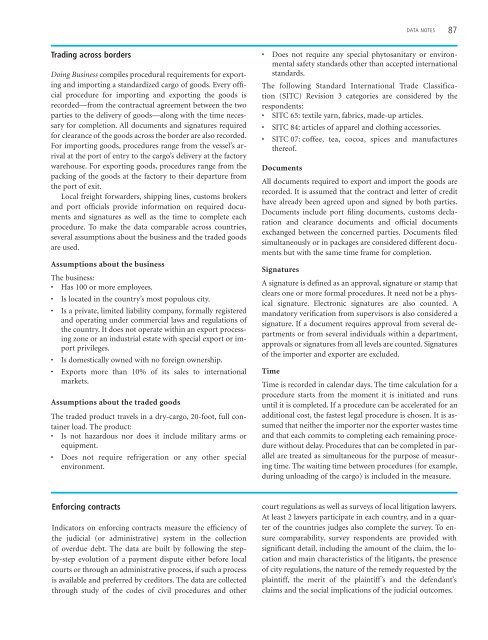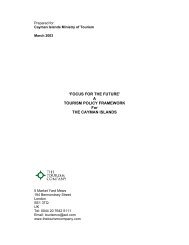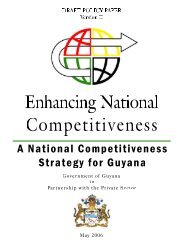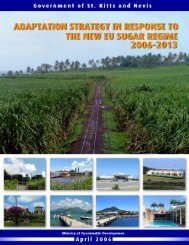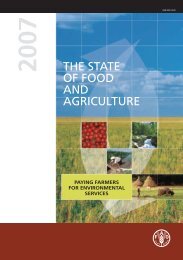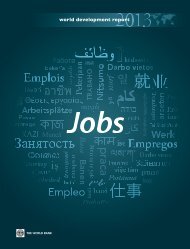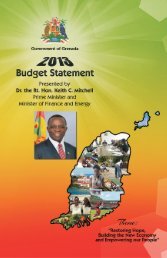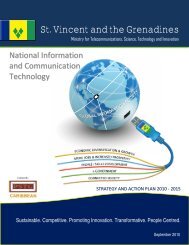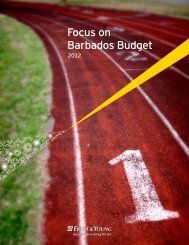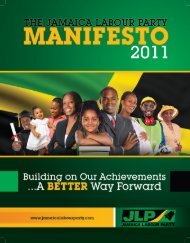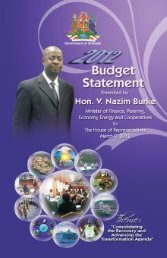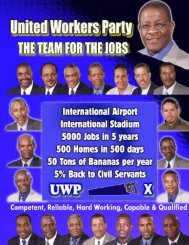Creating
Doing Business in 2006 -- Creating Jobs - Caribbean Elections
Doing Business in 2006 -- Creating Jobs - Caribbean Elections
Create successful ePaper yourself
Turn your PDF publications into a flip-book with our unique Google optimized e-Paper software.
DATA NOTES 87<br />
Trading across borders<br />
Doing Business compiles procedural requirements for exporting<br />
and importing a standardized cargo of goods. Every official<br />
procedure for importing and exporting the goods is<br />
recorded—from the contractual agreement between the two<br />
parties to the delivery of goods—along with the time necessary<br />
for completion. All documents and signatures required<br />
for clearance of the goods across the border are also recorded.<br />
For importing goods, procedures range from the vessel’s arrival<br />
at the port of entry to the cargo’s delivery at the factory<br />
warehouse. For exporting goods, procedures range from the<br />
packing of the goods at the factory to their departure from<br />
the port of exit.<br />
Local freight forwarders, shipping lines, customs brokers<br />
and port officials provide information on required documents<br />
and signatures as well as the time to complete each<br />
procedure. To make the data comparable across countries,<br />
several assumptions about the business and the traded goods<br />
are used.<br />
Assumptions about the business<br />
The business:<br />
• Has 100 or more employees.<br />
• Is located in the country’s most populous city.<br />
• Is a private, limited liability company, formally registered<br />
and operating under commercial laws and regulations of<br />
the country. It does not operate within an export processing<br />
zone or an industrial estate with special export or import<br />
privileges.<br />
• Is domestically owned with no foreign ownership.<br />
• Exports more than 10% of its sales to international<br />
markets.<br />
Assumptions about the traded goods<br />
The traded product travels in a dry-cargo, 20-foot, full container<br />
load. The product:<br />
• Is not hazardous nor does it include military arms or<br />
equipment.<br />
• Does not require refrigeration or any other special<br />
environment.<br />
• Does not require any special phytosanitary or environmental<br />
safety standards other than accepted international<br />
standards.<br />
The following Standard International Trade Classification<br />
(SITC) Revision 3 categories are considered by the<br />
respondents:<br />
• SITC 65: textile yarn, fabrics, made-up articles.<br />
• SITC 84: articles of apparel and clothing accessories.<br />
• SITC 07: coffee, tea, cocoa, spices and manufactures<br />
thereof.<br />
Documents<br />
All documents required to export and import the goods are<br />
recorded. It is assumed that the contract and letter of credit<br />
have already been agreed upon and signed by both parties.<br />
Documents include port filing documents, customs declaration<br />
and clearance documents and official documents<br />
exchanged between the concerned parties. Documents filed<br />
simultaneously or in packages are considered different documents<br />
but with the same time frame for completion.<br />
Signatures<br />
A signature is defined as an approval, signature or stamp that<br />
clears one or more formal procedures. It need not be a physical<br />
signature. Electronic signatures are also counted. A<br />
mandatory verification from supervisors is also considered a<br />
signature. If a document requires approval from several departments<br />
or from several individuals within a department,<br />
approvals or signatures from all levels are counted. Signatures<br />
of the importer and exporter are excluded.<br />
Time<br />
Time is recorded in calendar days. The time calculation for a<br />
procedure starts from the moment it is initiated and runs<br />
until it is completed. If a procedure can be accelerated for an<br />
additional cost, the fastest legal procedure is chosen. It is assumed<br />
that neither the importer nor the exporter wastes time<br />
and that each commits to completing each remaining procedure<br />
without delay. Procedures that can be completed in parallel<br />
are treated as simultaneous for the purpose of measuring<br />
time. The waiting time between procedures (for example,<br />
during unloading of the cargo) is included in the measure.<br />
Enforcing contracts<br />
Indicators on enforcing contracts measure the efficiency of<br />
the judicial (or administrative) system in the collection<br />
of overdue debt. The data are built by following the stepby-step<br />
evolution of a payment dispute either before local<br />
courts or through an administrative process, if such a process<br />
is available and preferred by creditors. The data are collected<br />
through study of the codes of civil procedures and other<br />
court regulations as well as surveys of local litigation lawyers.<br />
At least 2 lawyers participate in each country, and in a quarter<br />
of the countries judges also complete the survey. To ensure<br />
comparability, survey respondents are provided with<br />
significant detail, including the amount of the claim, the location<br />
and main characteristics of the litigants, the presence<br />
of city regulations, the nature of the remedy requested by the<br />
plaintiff, the merit of the plaintiff’s and the defendant’s<br />
claims and the social implications of the judicial outcomes.


